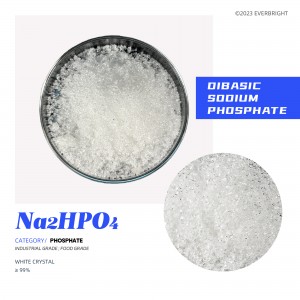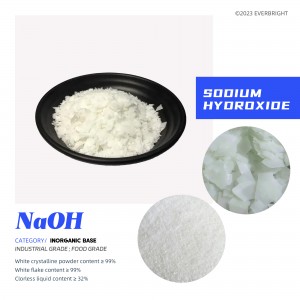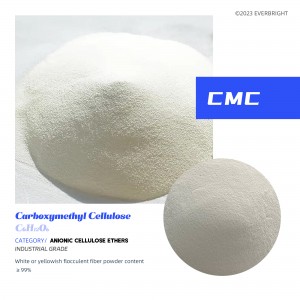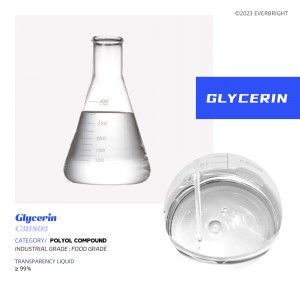-

Potassium Hydroxide (KOH)
It is a kind of inorganic compound, the chemical formula is KOH, is a common inorganic base, with strong alkalinity, the pH of 0.1mol/L solution is 13.5, soluble in water, ethanol, slightly soluble in ether, easy to absorb water in the air and deliquescent, absorb carbon dioxide and become potassium carbonate, mainly used as raw materials for the production of potassium salt, can also be used for electroplating, printing and dyeing.
-

Dibasic Sodium Phosphate
It is one of the sodium salts of phosphoric acid. It is a deliquescent white powder, soluble in water, and the aqueous solution is weakly alkaline. Disodium hydrogen phosphate is easy to weather in the air, at room temperature placed in the air to lose about 5 crystal water to form heptahydrate, heated to 100℃ to lose all the crystal water into anhydrous matter, decomposition into sodium pyrophosphate at 250℃.
-

Sodium Hydroxide
It is a kind of inorganic compound, also known as caustic soda, caustic soda, caustic soda, sodium hydroxide has strong alkaline, extremely corrosive, can be used as acid neutralizer, with masking agent, precipitating agent, precipitation masking agent, color agent, saponification agent, peeling agent, detergent, etc., the use is very wide.
-

Ammonium Sulfate
An inorganic substance, colorless crystals or white particles, odorless. Decomposition above 280℃. Solubility in water: 70.6g at 0℃, 103.8g at 100℃. Insoluble in ethanol and acetone. A 0.1mol/L aqueous solution has a pH of 5.5. The relative density is 1.77. Refractive index 1.521.
-

Sodium Tripolyphosphate(STPP)
Sodium tripolyphosphate is an inorganic compound containing three phosphate hydroxyl groups (PO3H) and two phosphate hydroxyl groups (PO4). It is white or yellowish, bitter, soluble in water, alkaline in aqueous solution, and releases a lot of heat when dissolved in acid and ammonium sulfate. At high temperatures, it breaks down into products such as sodium hypophosphite (Na2HPO4) and sodium phosphite (NaPO3).
-

Magnesium Sulphate
A compound containing magnesium, a commonly used chemical and drying agent, consisting of the magnesium cation Mg2+ (20.19% by mass) and the sulfate anion SO2−4. White crystalline solid, soluble in water, insoluble in ethanol. Usually encountered in the form of the hydrate MgSO4·nH2O, for various n values between 1 and 11. The most common is MgSO4·7H2O.
-

CDEA 6501/6501h (Coconutt Diethanol Amide)
CDEA can enhance the cleaning effect, can be used as an additive, foam stabilizer, foam aid, mainly used in the manufacture of shampoo and liquid detergent. An opaque mist solution is formed in water, which can be completely transparent under a certain agitation, and can be completely dissolved in different kinds of surfactants at a certain concentration, and can also be completely dissolved in low carbon and high carbon.
-

Sodium Bisulfate
Sodium bisulphate, also known as sodium acid sulfate, is sodium chloride (salt) and sulfuric acid can react at high temperatures to produce a substance, anhydrous substance has hygroscopic, aqueous solution is acidic. It is a strong electrolyte, completely ionized in the molten state, ionized into sodium ions and bisulfate. Hydrogen sulfate can only self-ionization, ionization equilibrium constant is very small, can not be completely ionized.
-

Carboxymethyl Cellulose(CMC)
At present, the modification technology of cellulose mainly focuses on etherification and esterification. Carboxymethylation is a kind of etherification technology. Carboxymethyl cellulose (CMC) is obtained by carboxymethylation of cellulose, and its aqueous solution has the functions of thickening, film formation, bonding, moisture retention, colloidal protection, emulsification and suspension, and is widely used in washing, petroleum, food, medicine, textile and paper and other industries. It is one of the most important cellulose ethers.
-

Glycerol
A colorless, odorless, sweet, viscous liquid that is non-toxic. The glycerol backbone is found in lipids called triglycerides. Because of its antibacterial and antiviral properties, it is widely used in FDA-approved wound and burn treatment. Conversely, it is also used as a bacterial medium. It can be used as an effective marker to measure liver disease. It is also widely used as a sweetener in the food industry and as a humectant in pharmaceutical formulations. Due to its three hydroxyl groups, glycerol is miscible with water and hygroscopic.
-

Ammonium Chloride
Ammonium salts of hydrochloric acid, mostly by-products of the alkali industry. Nitrogen content of 24% ~ 26%, white or slightly yellow square or octahedral small crystals, powder and granular two dosage forms, granular ammonium chloride is not easy to absorb moisture, easy to store, and powdered ammonium chloride is more used as a basic fertilizer for the production of compound fertilizer. It is a physiological acid fertilizer, which should not be applied on acidic soil and saline-alkali soil because of more chlorine, and should not be used as seed fertilizer, seedling fertilizer or leaf fertilizer.







